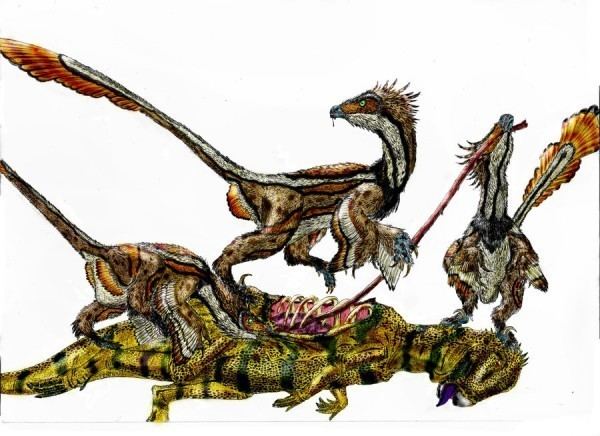Kingdom Animalia Clade Dinosauria Suborder Theropoda Higher classification Dromaeosauridae | Phylum Chordata Order Saurischia Family †Dromaeosauridae Rank Genus | |
 | ||
Similar Dinosaur, Pyroraptor, Rhabdodon, Theropods, Dromaeosauridae | ||
Variraptor (/ˈværᵻræptər/ VARR-i-rap-tor; "Var thief") is a genus of coelurosaurian theropod dinosaur from the Late Cretaceous of France.
Contents
DiscoveryEdit

Between 1992 and 1995 amateur paleontologists Patrick Méchin and Annie Méchin-Salessy uncovered the remains of a small theropod in the Grès à Reptiles Formation (Campanian-Maastrichtian) at La Bastide Neuve, near Fox-Amphoux. The first finds were in 1992 assigned to the dubious theropod genus Elopteryx. A second article, in 1997, concluded they represented a new species. In 1998 this was named by Jean Le Loeuff and Eric Buffetaut as the type species Variraptor mechinorum. The generic name is derived from Latin Varus, referring to the Var River in the Alpes-Maritimes department in the Provence region of southern France, and raptor meaning "thief". The specific name honours the Méchin couple.

The genus is based on three type specimens: a posterior dorsal vertebra (MDE-D168), a sacrum (MDE-D169) with five fused vertebrae, and an ilium (CM-645). The specimens are part of the collection of the Musée des Dinosaures d'Espéraza and the private Collection Méchin.

Additional referred material includes a right humerus (MDE-D158) with a deltopectoral crest more developed than in any other known theropod, suggesting a strong raptorial function for the forearm. Other attributed bones include a femur and various vertebrae.
DescriptionEdit
The incomplete remains have dromaeosaurid features in the shape of the vertebrae and the humerus, with some resemblances to Deinonychus. An adult animal may have been slightly smaller than Deinonychus at around two meters (6.5 ft) long. However, the identity of the referred fossils has become uncertain.
ClassificationEdit
In 2000 Ronan Allain and Philippe Taquet named a second small theropod from the same layers: Pyroraptor. They also claimed that Variraptor was a nomen dubium because the type lacked any single diagnostic trait.
In 2009 Buffetaut and Phomphen Chanthasit defended the validity of Variraptor, arguing the type had a unique combination of traits. The lack of overlapping parts would make it impossible to establish whether Pyroraptor was a junior subjective synonym but the presence of two different types of ulna in the southern French dromaeosaurid material would indicate two separate species.
Le Loeuff and Buffetaut described Variraptor as a maniraptoran theropod, a member of the Dromaeosauridae, and this has been commonly accepted. However, in 2000 Oliver Rauhut was doubtful, assigning it to the more inclusive Coelurosauria.
